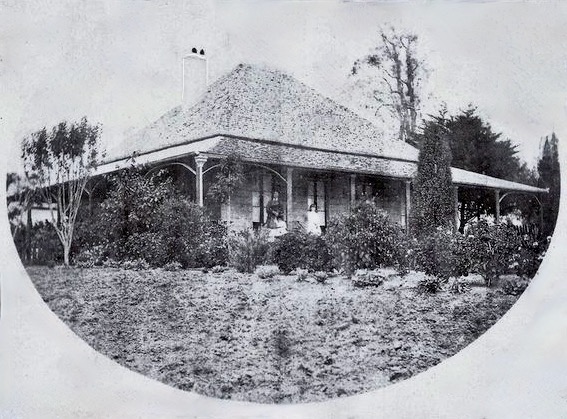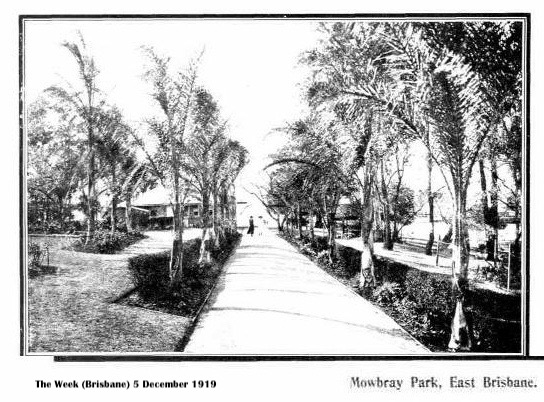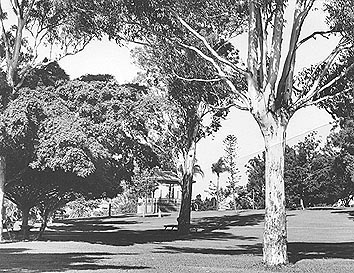The RIVERSDALE – RAVENSCOTT – ESKGROVE connection
The Reverend Thomas Mowbray, Reverend Robert Creyke and former banker Archibald Hutchinson played a significant role in the early development of Kangaroo Point and East Brisbane before separation on 10 Dec 1859. They joined an elite group of gentry and pastoralists who established prominent riverine town estates in the mid-nineteenth century. These included Newstead House

(1846), Toogoolawah (now Bulimba House, 1849-50), Riversdale (now Mowbray Park, early 1850s), Ravenscott (now Shafston, 1851); Milton (ca. 1852-53) and Eskgrove (1853).
After Moreton Bay officially ceased to be a penal colony on 10 February 1842 Brisbane Town was named its centre and the area was opened up for free settlers. The first Moreton Bay land sales took place in Sydney in July 1842 and in Brisbane in August 1843. The first land sales on Kangaroo Point and the East Brisbane area took place on 20 March 1844 and the first residence in Kangaroo Point was built by surveyor James Warner in the same year.
In mid-1850 James Warner surveyed the southern part of Kangaroo Point along the riverfront up to Norman Creek into acreage allotments. The Crown then offered these for sale as what were known as the Eastern Suburban Allotments. Three purchasers at this land sale were to establish imposing riverfront estates and play an important role in the development of their suburbs.

December 1850: The Rev. Thomas Mowbray (Presbyterian) bought 13 acres of riverfront land and c. 1851 built a large stone cottage called Riversdale on a high part with river views. He also established a school there.

November 1851: The Rev. Robert Creyke (Church of England) bought Lot 44-45, 10 acres with river frontage and built a single-story stone house called Ravenscott (later to become Shafston) on lot 44.

February 1853 – Archibald Hutchinson, Scottish-born former Sydney bank manager bought allotments 51-53 totalling 12.5 acres (about 5 hectares) for £88/10/1 from surveyor James Charles Burnett who had bought them between Nov 1851-Dec 1852, but it is not clear whether or not he lived there. Hutchinson built a stone cottage called Eskgrove downstream from Shafston and Riversdale.
All three properties are now listed on the Queensland State Heritage Register. (source: SLQ/State Heritage Register/)
Part 2: Riversdale and growth of East Brisbane
This extract from an article in the Brisbane Courier of 24 January 1931 is a good summary of the important role played by the Rev. Thomas Mowbray in the development of East Brisbane and the legacy of the Mowbray family.
Part 3: Riversdale and the Mowbray legacy
Riversdale, the large stone house built for the Rev Thomas Mowbray ca. 1851 was located on a high part of the 13 acres of riverfront land in what was then known as Kangaroo Point and had extensive river views. The house was set in picturesque surroundings with beautiful gardens, flowering vines and wild lime trees. There was also a small shallow lagoon on the western side which attracted many water birds and the Queensland water dragons.
Riversdale became a social hub for local society and many popular functions were held there. Rev. Mowbray also ran what could be called the first grammar school there, sharing his love of classical Latin and Greek with the children of settlers.
Due to his ongoing ill health he could only work part-time on his church ministry. However, he was highly regarded and well liked and became known as the Father of Presbyterianism as he played a key role in the opening of Brisbane’s first Presbyterian church in Grey St, South Brisbane in May 1851.
He died on 23 December 1867 aged 55 and was buried at the Paddington Cemetery (now Lang Park), but his remains were later transferred to the South Brisbane Cemetery. At the time the Mowbray Estate had increased to 83 acres.
In 1884 his widow, Williamina Mowbray, sold a large part of the estate south of Lytton Road up to Mowbray Terrace for subdivision. The new estate consisted of 336 fourteen perch blocks and was named Mowbraytown. Shortly after the council passed a law requiring future lots for residential sub-divisions to be a minimum of sixteen perches. Williamina later bought back two blocks in Mowbray Terrace and donated them for the building of a church, in memory of her husband’s ministry.
The Mowbraytown Presbyterian Church and Hall were built in 1885. The Mowbray children were active members of the congregation in the early years.
Williamina Mowbray died at Riversdale on 29 July 1890 and was buried in Dutton Park Cemetery. Members of the family continued to live in Riversdale and retained the land between Lytton Road and the river until 1903. In 1903/4 the rest of the property then known as Mowbray’s Paddock was sold to the South Brisbane City Council for £5,743. The gardens were opened to the public and renamed Mowbray Park. The house was removed in the same year (sold for removal for £9) and the lagoon was eventually drained.

Mowbray Park, 1949 (Brisbane City Council Images)Since then Mowbray Park has become a popular riverside park and sports and recreation centre for the people of Brisbane. Over the years there have been many significant changes. A band rotunda opened in February 1911 and a park keeper’s house with a kiosk (1910) were believed to be situated on the hill where Riversdale once stood.

Leases for a lawn bowls club, a croquet club and a tennis club were issued from 1905. A jetty was built in 1911 and children’s playground in 1914.


There were enclosed public tidal baths from the 1920 to 1940 and a swimming club and surf life saving club.
In 1916-17 the first WWI War Memorial in Brisbane with its unique digger statue was built on the hill near Lytton Road and opened on 11 August 1917. The park became a ‘tent city’ for homeless during the 1930s Depression.
Sailing regattas were popular in the 1920s and 1930s. In the 1930s a boat house for use by the Church of England Grammar School (Churchie) rowing club was built at the Laidlaw Parade end of the park.
As part of major changes to the park in 1976 the kiosk, caretaker’s cottage and bandstand were demolished and the tennis courts and scout dens removed. Contour and planting changes have been ongoing since then.

Mowbray Park, including the East Brisbane War Memorial, was entered on the Queensland State Heritage Register on 21 October 1992 in recognition of its significance as part of the development of East Brisbane and the contribution made by the Mowbray family. It is a fitting tribute to the achievements of a much loved and highly respected first settler and his family and will ensure that the Mowbray name will never be forgotten.
(source: Mowbraytown Heritage by Joy Loggie; Queensland State Heritage Register; SLQ; Trove articles).
